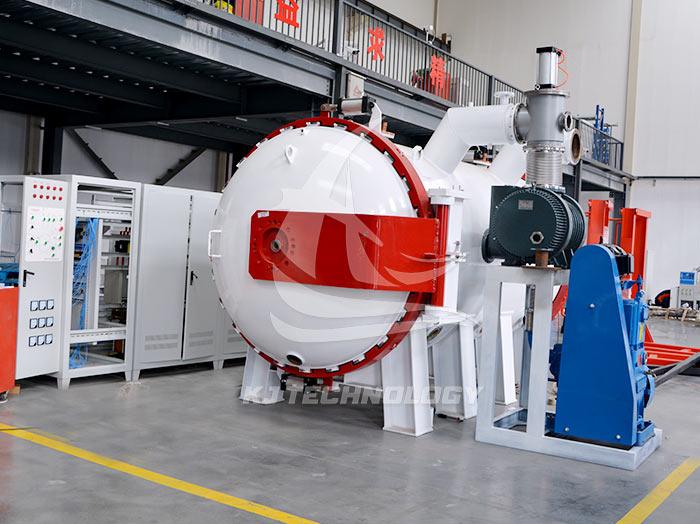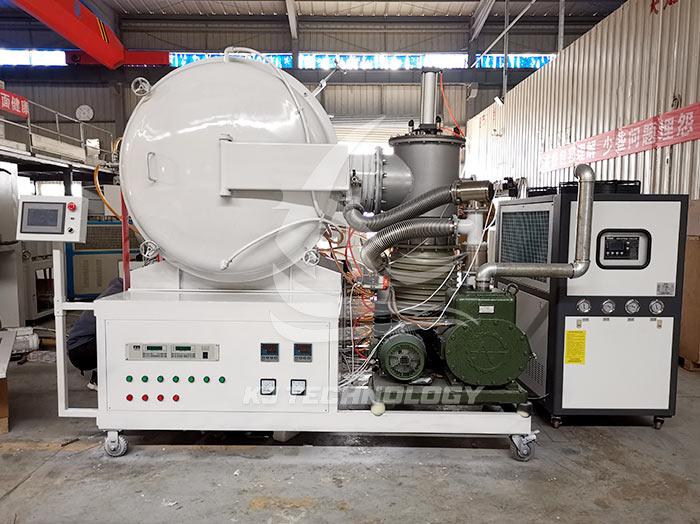Daily maintenance of vertical graphite carbon tube vacuum furnace
 10-17-2025 Author: KJ technology
10-17-2025 Author: KJ technology
The daily maintenance of the vertical graphite carbon tube vacuum furnace is the key to ensuring stable operation of the equipment, extending its service life, and ensuring sintering quality. The following provides a detailed introduction to the specific content of daily maintenance from five aspects: daily cleaning, component inspection and maintenance, lubrication maintenance, safety system inspection, and recording and preventive maintenance:
1. Daily cleaning
Furnace cleaning
Remove residues: After each batch of sintering is completed, use a dust-free cloth or soft bristled brush to clean the residue (such as oxides and carbon deposits) on the inner wall of the furnace, heating elements (graphite carbon tubes), and furnace bottom plate to avoid affecting the uniformity of the next sintering.
Avoid scratching with hard objects: Clean gently to prevent scratching the graphite surface or damaging the heating element.
Observation window cleaning
Regular wiping: Use a specialized cleaning agent (such as alcohol) to wipe the observation window to maintain transparency and facilitate real-time observation of the furnace situation.
Check sealing: After cleaning, check whether the sealing ring of the observation window is intact, without aging or deformation.
External cleaning
Dust removal and pollution prevention: Wipe the exterior of the furnace with a dry cloth daily to remove dust and oil stains and prevent corrosion.
Check the heat dissipation holes: Ensure that the heat dissipation holes are unobstructed and maintain good ventilation of the equipment.
2. Component inspection and maintenance
Heating element inspection
Appearance inspection: Check the graphite carbon tubes weekly for cracks, oxidation, or detachment, especially for loose connections.
Resistance measurement: Use a multimeter to measure the resistance value of the heating element every month, and compare it with the initial value. If the deviation exceeds 10%, it needs to be replaced.
Replacement cycle: Based on the frequency of use, it is recommended to replace the graphite carbon tube every 6-12 months to prevent a decrease in heating efficiency due to aging.
Vacuum system maintenance
Vacuum pump inspection: Check the oil level and quality of the vacuum pump daily. If the oil level is below the lower limit, it needs to be replenished. If the oil quality is cloudy, it needs to be replaced (it is recommended to replace it every 3 months).
Seal inspection: Check the sealing rings at the furnace door and flange connection every month for aging, cracks, or deformation, and replace them if necessary.
Pipeline cleaning: Blow the vacuum pipeline with compressed air every quarter to remove dust and foreign objects and prevent blockage.
Temperature control system calibration
Temperature sensor inspection: Calibrate the temperature sensor inside the furnace with a standard thermometer every month to ensure measurement accuracy within ± 1 ℃.
Temperature controller parameter verification: Check whether the temperature controller parameter settings are consistent with the process requirements to avoid temperature fluctuations caused by parameter errors.
3. Lubrication and maintenance
Lubrication of transmission components
Lifting mechanism: Apply high-temperature lubricating grease (such as molybdenum disulfide grease) to the furnace lifting guide rail and screw every month to reduce wear.
Rotating components: Regularly add lubricating oil (such as 32 # mechanical oil) to rotating components such as vacuum pumps and valves to ensure smooth operation.
Chain and belt inspection
Tension adjustment: Check the tension of the transmission chain and belt every quarter. If it is too loose, adjust it; if it is too tight, replace it to prevent breakage.
Wear inspection: Check the surface of the chain and belt for wear, and replace them immediately if there are cracks or fractures.
4. Security system inspection
Electrical safety
Grounding detection: Use a grounding resistance tester to check the grounding resistance of the equipment every month to ensure it is ≤ 4 Ω.
Insulation inspection: Use a megohmmeter to test the insulation performance of heating elements and power lines every quarter, with an insulation resistance of ≥ 1M Ω.
Leakage protection: Test whether the leakage protection switch operates normally to ensure personal safety.
Pressure safety
Pressure relief valve inspection: Manually test the flexibility of the pressure relief valve and safety valve every month to ensure timely pressure relief in case of overpressure.
Pressure gauge calibration: Calibrate the pressure gauge every six months to ensure accurate display.
Gas safety
Gas pipeline inspection: Check the gas pipeline and valves daily for leaks, apply soapy water to the interface, and if no bubbles are produced, it is considered qualified.
Ventilation system inspection: Ensure that the exhaust volume in the operating room is ≥ 300m ³/h and promptly discharge trace gases.
5. Record keeping and preventive maintenance
Maintenance Record
Establish a ledger: record the time, content, replacement parts, and operator information of each maintenance for easy traceability.
Problem feedback: When equipment abnormalities are detected, promptly record the fault symptoms and handling measures to provide reference for subsequent repairs.
Preventive Maintenance Plan
Develop cycle: Based on the frequency of equipment usage and manufacturer recommendations, develop an annual preventive maintenance plan (such as a comprehensive inspection every six months).
Spare parts reserve: Reserve commonly used spare parts (such as graphite carbon tubes, sealing rings, vacuum pump oil) to shorten maintenance cycles.
Operator training
Regular training: Organize operators to learn equipment maintenance knowledge, improve maintenance awareness and skills.
Safety drill: Regularly conduct emergency response drills (such as temperature runaway, vacuum leakage) to ensure that personnel can respond quickly.








